No amount of theory tests for e-riders will be enough to make our roads safer
06 May 2021|8,677 views
The Land Transport Authority (LTA) announced that from 30 June, electric scooter and electric bicycle riders will have to take a mandatory online theory test. This test will cover three modules, and two handbooks have been published online that cover general information on active mobility devices, pre-journey and equipment checks, as well as the rules and codes of conduct for using the devices.
This announcement comes after a slate of incidents involving Personal Mobility Devices (PMD), with the latest headline being an e-scooter rider pleading guilty to causing the death of an elderly cyclist in a 2019 accident. The Government has also continually been reviewing regulations when it comes to PMDs, with the latest set of restrictions being put in place in August 2020.
So, will this mandatory theory test help curb the number of accidents? Is that enough to make roads safer for everyone?
Necessary enforcement
This theory test is yet another step in a continuing uptick of enforcement of such devices, starting with the Active Mobility Act (AMA) established in 2018. And of course, enforcement is necessary. Just as cars and motorcycles have to abide by traffic rules and regulation, it is only logical that other modes of transport need to meet certain regulatory standards as well.
Adhering to speed limits is a key part to safety. Presently, there is an e-scooter/e-bike inspection, which enforces the weight, size and speed limit of the device. Beyond the initial inspection, motorised PMDs are required to undergo inspection every two years. In all likelihood, this inspection interval will probably be revised and shortened if incidents continue to occur regularly.
Unsurprisingly, the Government is very quick and effective in wielding the stick - more rules and regulation, increasing enforcement, harsher punishment.
Limits to enforcement
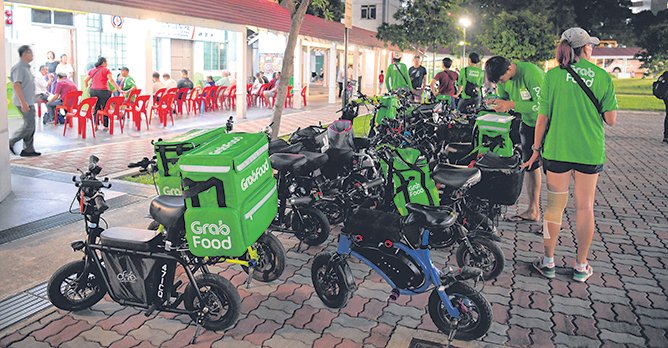
What's next? A practical test in the vein of motorcyclists and car drivers? Establishing a new driving license? No, that doesn't seem practical. Beyond just the logistical challenges, as Singapore pursues a car-lite future, creating new barriers to entry to the adoption of such mobility devices seems fundamentally unproductive and counter intuitive.
At this rate, we should not continue to just impose new rules and increase enforcement. This will only continue to create further tension among PMD users, especially those that may rely on such devices for their livelihoods (such as delivery riders).
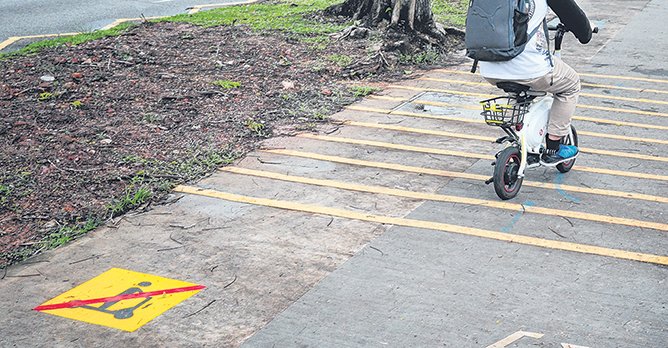
Building a new eco-system
This new theory test also puts the onus of responsibility on the individual. Yes, while it would be great if everyone was a courteous road user and followed all the rules, we all know that isn't always the case.
Further complicating the matter is the distinction between pedestrian footpaths, cycling paths or PCNs, as well as roads. Different types of PMDs are allowed on different types on paths, and I honestly couldn't tell you which is which.
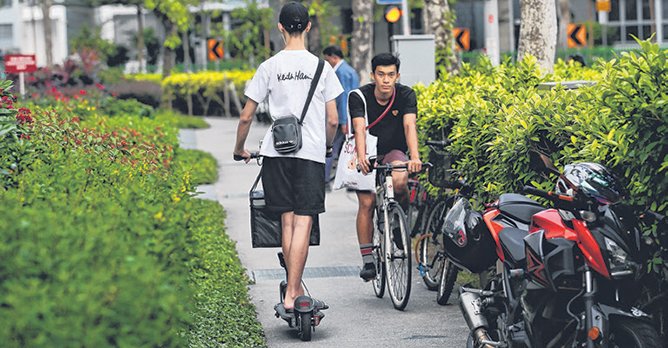
This new mandatory theory test is a step in the right direction, but ultimately it is but a stop-gap measure. To further improve the safety of all road users, there is a need to establish more cycling paths that will allow e-bicycle and e-scooter users to travel on, separate from pedestrian footpaths. This will fundamentally reduce the interaction between these distinct groups, and thus reduce the chances of accidents.
Just as cars on the roads have lane markings to help people keep a safe distance from one another, our footpaths and cycling paths should be clearly delineated too. Will that mean no accidents will happen? Of course not. Accidents happen on roads too. But, it will establish a distinct transportation eco-system that no amount of online tests can do.
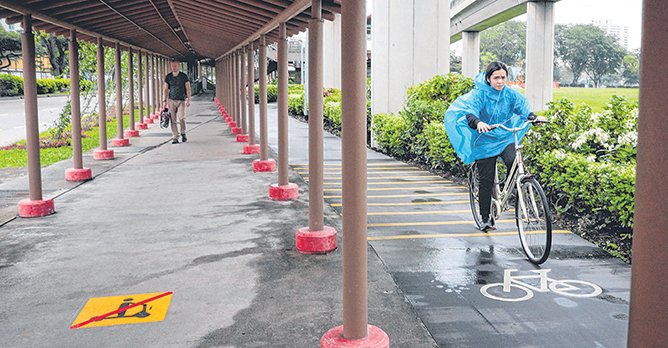
Singapore has a long way to go, but investment is required across all three parameters. Further enforcement and more tests do little to further the streetscape and cultural parameters to make mobility devices a more accessible, practical and safer means of getting around.
As we continue to address the matter of co-existing with other forms of transportation on our roads and pathways, it would be prudent to take a multi-prong approach. More rules and enforcement are just one aspect. There should also be continued investment in infrastructure to create a conducive environment within which PMDs can operate, thus, minimising their overlap with pedestrians and motor vehicles.
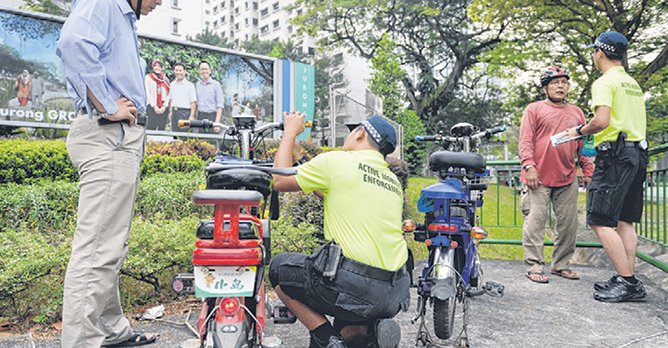
This is the carrot that must come with the inevitable stick. Instead of simply disciplining PMD users to get them to become 'less-bad' riders, there is also a need to offer some clear incentives and benefits to motivate PMD users to become 'more-good' riders.
At the same time, there is a need for better education such that all road users learn to be more courteous and accommodating to one another. It is only then that we can see better behaviour from all parties - drivers, riders, and pedestrians who all co-exist within our larger transportation eco-system.
The Land Transport Authority (LTA) announced that from 30 June, electric scooter and electric bicycle riders will have to take a mandatory online theory test. This test will cover three modules, and two handbooks have been published online that cover general information on active mobility devices, pre-journey and equipment checks, as well as the rules and codes of conduct for using the devices.
This announcement comes after a slate of incidents involving Personal Mobility Devices (PMD), with the latest headline being an e-scooter rider pleading guilty to causing the death of an elderly cyclist in a 2019 accident. The Government has also continually been reviewing regulations when it comes to PMDs, with the latest set of restrictions being put in place in August 2020.
So, will this mandatory theory test help curb the number of accidents? Is that enough to make roads safer for everyone?
Necessary enforcement
This theory test is yet another step in a continuing uptick of enforcement of such devices, starting with the Active Mobility Act (AMA) established in 2018. And of course, enforcement is necessary. Just as cars and motorcycles have to abide by traffic rules and regulation, it is only logical that other modes of transport need to meet certain regulatory standards as well.
Adhering to speed limits is a key part to safety. Presently, there is an e-scooter/e-bike inspection, which enforces the weight, size and speed limit of the device. Beyond the initial inspection, motorised PMDs are required to undergo inspection every two years. In all likelihood, this inspection interval will probably be revised and shortened if incidents continue to occur regularly.
Unsurprisingly, the Government is very quick and effective in wielding the stick - more rules and regulation, increasing enforcement, harsher punishment.
Limits to enforcement

What's next? A practical test in the vein of motorcyclists and car drivers? Establishing a new driving license? No, that doesn't seem practical. Beyond just the logistical challenges, as Singapore pursues a car-lite future, creating new barriers to entry to the adoption of such mobility devices seems fundamentally unproductive and counter intuitive.
At this rate, we should not continue to just impose new rules and increase enforcement. This will only continue to create further tension among PMD users, especially those that may rely on such devices for their livelihoods (such as delivery riders).

Building a new eco-system
This new theory test also puts the onus of responsibility on the individual. Yes, while it would be great if everyone was a courteous road user and followed all the rules, we all know that isn't always the case.
Further complicating the matter is the distinction between pedestrian footpaths, cycling paths or PCNs, as well as roads. Different types of PMDs are allowed on different types on paths, and I honestly couldn't tell you which is which.

This new mandatory theory test is a step in the right direction, but ultimately it is but a stop-gap measure. To further improve the safety of all road users, there is a need to establish more cycling paths that will allow e-bicycle and e-scooter users to travel on, separate from pedestrian footpaths. This will fundamentally reduce the interaction between these distinct groups, and thus reduce the chances of accidents.
Just as cars on the roads have lane markings to help people keep a safe distance from one another, our footpaths and cycling paths should be clearly delineated too. Will that mean no accidents will happen? Of course not. Accidents happen on roads too. But, it will establish a distinct transportation eco-system that no amount of online tests can do.

Singapore has a long way to go, but investment is required across all three parameters. Further enforcement and more tests do little to further the streetscape and cultural parameters to make mobility devices a more accessible, practical and safer means of getting around.
As we continue to address the matter of co-existing with other forms of transportation on our roads and pathways, it would be prudent to take a multi-prong approach. More rules and enforcement are just one aspect. There should also be continued investment in infrastructure to create a conducive environment within which PMDs can operate, thus, minimising their overlap with pedestrians and motor vehicles.

This is the carrot that must come with the inevitable stick. Instead of simply disciplining PMD users to get them to become 'less-bad' riders, there is also a need to offer some clear incentives and benefits to motivate PMD users to become 'more-good' riders.
At the same time, there is a need for better education such that all road users learn to be more courteous and accommodating to one another. It is only then that we can see better behaviour from all parties - drivers, riders, and pedestrians who all co-exist within our larger transportation eco-system.
Thank You For Your Subscription.

























